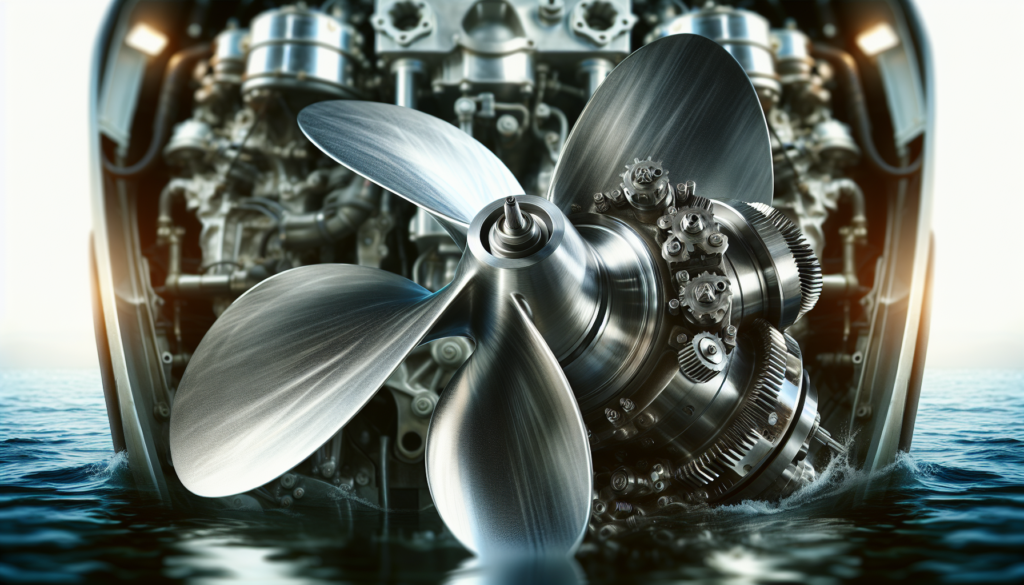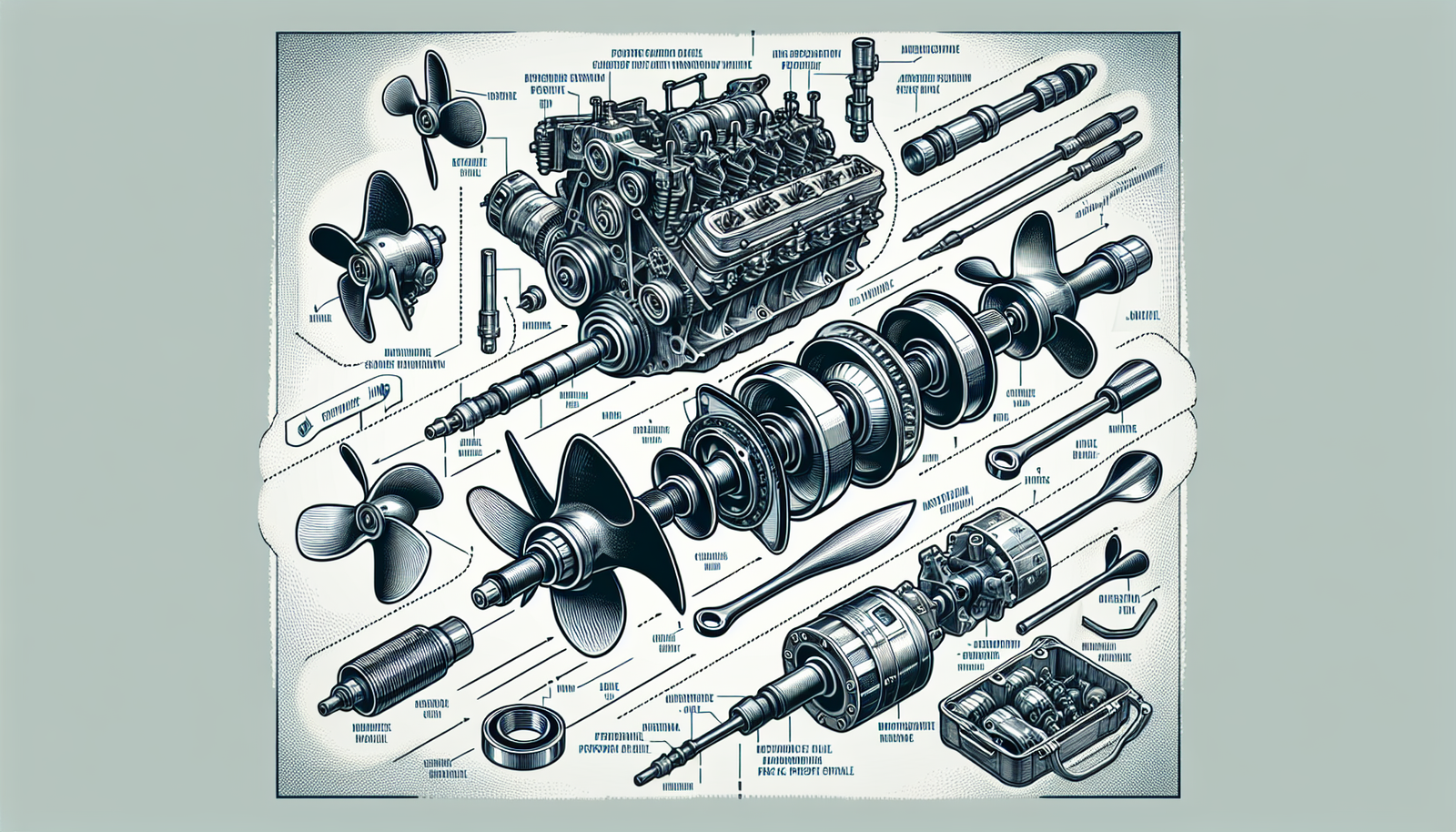Have you ever wondered how propeller modifications can affect the performance of boat engines? In this article, we will explore the fascinating world of propeller modification and its potential impact on boat engines. From increasing speed and fuel efficiency to improving maneuverability, propeller modifications have the power to transform your boating experience. Join us as we unravel the mysteries behind this often-overlooked aspect of boat mechanics and discover how small changes to your propeller can make a big difference on the water.

Different Types of Propeller Modifications
Cupping
Cupping is a propeller modification technique where the trailing edge of the propeller blades is curved inwards. This creates a cup-like shape, which can have several benefits for boat engines. Cupping increases the propeller’s grip in the water, allowing for improved acceleration and enhanced cavitation resistance. However, it’s important to note that cupping may potentially lead to a decrease in the boat’s top speed.
Pitch Adjustment
Pitch adjustment involves changing the angle at which the propeller blades meet the water. By adjusting the pitch, boat owners can optimize the engine’s performance and achieve the desired RPM range. This modification technique allows for a fine-tuning of the balance between speed and torque, and it can also have an impact on fuel consumption. It’s crucial to consider the boat’s purpose and usage when deciding on a pitch adjustment.
Trimming Blades
Trimming the blades refers to adjusting the boat’s bow angle by altering the trim tabs or using hydrofoils. This modification helps reduce drag and resistance, leading to enhanced fuel efficiency. Additionally, trimming the blades can improve maneuverability, making it easier to navigate through different water conditions. It’s important to consult with professionals to ensure proper adjustments are made to maximize the benefits.
Changing the Number of Blades
Another propeller modification option involves altering the number of blades on the propeller. Increasing or decreasing the number of blades can have various effects on a boat’s performance and handling. Increasing the number of blades can increase propulsion efficiency and stability, but it may also lead to higher levels of noise and vibration. On the other hand, decreasing the number of blades can result in improved steering and handling, but it may also reduce propulsion efficiency.
Benefits of Propeller Modifications
Increased Fuel Efficiency
One of the significant advantages of propeller modifications is increased fuel efficiency. By optimizing the performance of the propeller, boat owners can reduce the amount of fuel consumed during their trips. Cupping, pitch adjustment, trimming blades, and changing the number of blades can all contribute to improved fuel efficiency, resulting in cost savings and a reduced environmental impact.
Improved Boat Handling
Propeller modifications can significantly enhance boat handling. Whether it’s through cupping, pitch adjustment, trimming blades, or changing the number of blades, these modifications can improve maneuverability, making it easier to navigate tight turns and different water conditions. Improved boat handling translates into a smoother and more enjoyable boating experience for owners and passengers alike.
Enhanced Performance and Speed
Another benefit of propeller modifications is the potential for improved performance and speed. Cupping, pitch adjustment, trimming blades, and changing the number of blades can all contribute to enhancing a boat’s overall performance. These modifications allow owners to fine-tune their boat’s propulsion system, resulting in increased speed and acceleration. This can be particularly beneficial for boat owners participating in racing or other speed-oriented activities.

Considerations Before Making Propeller Modifications
Boat’s Purpose and Usage
Before making any propeller modifications, it’s essential to consider the boat’s purpose and usage. Different types of boats require different propeller modifications to optimize performance. For example, a recreational boat may benefit from modifications that prioritize fuel efficiency and smooth handling, while a racing boat may require adjustments that prioritize speed and acceleration.
Engine Specifications
Another crucial consideration is the engine specifications of the boat. The propeller modifications chosen should be compatible with the boat’s engine power and torque. It’s important to consult the engine manufacturer’s guidelines to ensure that the modifications will not exceed the engine’s limitations and potentially cause damage.
Cost and Budget
Propeller modifications can vary in cost, depending on the type and extent of the modifications. Before pursuing any modifications, it’s important to set a budget and consider the cost implications. It may be necessary to research different options and consult professionals to determine the most cost-effective modifications that align with your budget.
Professional Advice
Seeking professional advice is highly recommended when considering propeller modifications. An experienced marine mechanic or a boat manufacturer can provide invaluable insights and recommendations based on your specific boat and engine combination. They can assess your needs, evaluate the potential benefits and drawbacks of different modifications, and ensure proper installation.
Potential Drawbacks of Propeller Modifications
Reduced Top Speed
While propeller modifications can offer numerous benefits, they may also result in a reduced top speed. Cupping and even some changes in the number of blades can affect the overall performance and efficiency, potentially limiting the boat’s ability to reach its maximum speed. It’s important to weigh the trade-offs between increased fuel efficiency and potential speed reduction before making any modifications.
Decreased Acceleration
In certain cases, propeller modifications can lead to decreased acceleration. Changes in pitch adjustment, for example, can affect the propeller’s ability to grip the water, resulting in slower acceleration. It’s crucial to evaluate the trade-off between improved fuel efficiency and potential acceleration reduction, particularly if quick acceleration is a priority for your boating activities.
Increased Engine Stress
Propeller modifications can impact the stress placed on the boat’s engine. While some modifications aim to optimize engine performance, others may inadvertently increase stress levels. It’s important to carefully consider the compatibility of the modifications with your engine specifications to avoid placing unnecessary strain on the engine, potentially leading to reduced longevity or even failure.
Decreased Reverse Thrust
Certain propeller modifications may also result in decreased reverse thrust capabilities. This can impact the boat’s maneuverability in tight spaces, such as docking or reversing. It’s essential to evaluate the importance of reverse thrust for your specific boating needs and assess the potential impact of modifications on this crucial aspect of boat handling.

Effects of Cupping on Boat Engines
Increased Grip in the Water
One of the primary effects of cupping on boat engines is an increased grip in the water. The cupping shape allows for improved traction, especially during acceleration. The propeller blades can bite into the water more effectively, resulting in enhanced performance and quicker acceleration.
Enhanced Cavitation Resistance
Cavitation occurs when low-pressure bubbles form around the propeller blades, leading to a loss of power and decreased performance. Cupping helps reduce the likelihood of cavitation and improves the cavitation resistance of the propeller. This ensures that the engine can maintain its power output without being impeded by the negative effects of cavitation.
Improved Acceleration
Cupping can significantly improve a boat’s acceleration. By increasing the grip in the water, cupping enables the boat to generate more thrust and move forward more rapidly. This can be particularly beneficial in situations where quick acceleration is necessary, such as getting up to speed quickly or passing another vessel.
Potential Decrease in Top Speed
While cupping offers various benefits, it’s important to note that it may also result in a decrease in the boat’s top speed. The increased grip and resistance created by cupping may cause the engine to strain and limit its ability to achieve higher speeds. Boat owners should consider their priorities and evaluate the trade-off between improved acceleration and potential speed reduction before opting for cupping modifications.
Impact of Pitch Adjustment on Boat Engines
Optimizing Engine Performance
Pitch adjustment plays a crucial role in optimizing the engine’s performance. By adjusting the propeller pitch, boat owners can fine-tune the load on the engine, ensuring it operates within its optimal RPM range. This results in improved efficiency, reduced strain on the engine, and enhanced overall performance.
Achieving Desired RPM Range
Pitch adjustment allows boat owners to achieve their desired RPM range. This can be particularly important in applications where maintaining a specific RPM range is crucial, such as in specialized boating activities or when towing water sports enthusiasts. Careful pitch adjustment ensures that the engine operates consistently within the desired RPM range, maximizing both performance and fuel efficiency.
Balancing Speed and Torque
Pitch adjustment enables boat owners to strike the right balance between speed and torque. By adjusting the pitch, they can fine-tune the engine’s power output, optimizing it for their specific needs. Whether it’s prioritizing top speed or maximizing torque for towing, pitch adjustment allows for a customized approach to boat performance.
Effects on Fuel Consumption
Pitch adjustment can also have an impact on fuel consumption. By optimizing the engine’s performance and ensuring it operates within the desired RPM range, boat owners can achieve better fuel efficiency. Adjusting the pitch can help reduce unnecessary strain on the engine, resulting in decreased fuel consumption and longer operational hours per tank.

Trimming Blades and Its Influence on Boat Engines
Adjusting Boat’s Bow Angle
Trimming the blades involves adjusting the boat’s bow angle, typically using trim tabs or hydrofoils. By doing so, boat owners can change the boat’s attitude in the water, optimizing its performance. Adjusting the bow angle can help achieve a more efficient and balanced ride, ensuring that the boat planes properly and reduces frictional resistance.
Reducing Drag and Resistance
One of the key benefits of trimming blades is the reduction in drag and resistance. By adjusting the boat’s bow angle, boat owners can minimize the surface area in contact with the water, leading to reduced drag and improved efficiency. This results in faster speeds, improved fuel efficiency, and a smoother ride.
Enhancing Fuel Efficiency
Trimming blades can significantly enhance a boat’s fuel efficiency. By reducing drag and optimizing the boat’s attitude in the water, boat owners can reduce the power required to maintain a certain speed. This leads to decreased fuel consumption and prolonged endurance on the water, particularly during longer journeys or extended boating trips.
Improving Maneuverability
Trimming the blades can also improve a boat’s maneuverability. Adjusting the bow angle allows for more precise control over the boat’s movements, making it easier to navigate through different water conditions. This can be particularly beneficial in tight spaces, such as marinas or when maneuvering around other vessels.
Changing the Number of Blades and Its Effect on Boat Engines
Increasing or Decreasing Propulsion Efficiency
Changing the number of blades on a propeller can have a significant impact on a boat’s propulsion efficiency. Increasing the number of blades can enhance the propeller’s grip in the water, resulting in improved propulsion efficiency. On the other hand, decreasing the number of blades can reduce drag and potentially increase efficiency in certain applications.
Altering Noise and Vibration Levels
The number of blades on a propeller can also affect the noise and vibration levels experienced on a boat. Increasing the number of blades often leads to higher levels of noise and vibration, particularly at higher speeds. Conversely, decreasing the number of blades can help reduce noise and vibration, resulting in a smoother and more comfortable boating experience.
Modifying Boat Stability
Changing the number of blades on a propeller can also impact a boat’s stability. Increasing the number of blades can enhance stability, particularly in rough water conditions. Conversely, decreasing the number of blades may result in reduced stability, potentially affecting the boat’s performance and handling.
Impact on Steering and Handling
The number of blades on a propeller can have noticeable effects on steering and handling. Increasing the number of blades can improve steering response and overall handling characteristics. However, it may also require more effort to steer the boat. Conversely, decreasing the number of blades can result in lighter steering, but it may potentially impact stability and handling.

Factors Affecting the Impact of Propeller Modification
Boat Size and Weight
The size and weight of a boat play a significant role in the impact of propeller modifications. Larger and heavier boats may require more substantial modifications to achieve noticeable improvements in performance. Conversely, smaller and lighter boats may experience more dramatic results from modest adjustments.
Boat Hull Design
The shape and design of a boat’s hull can also affect the impact of propeller modifications. Different hull designs interact with the water in unique ways, and modifications should be tailored to accommodate the specific characteristics of the boat’s hull. It’s essential to consult with professionals who understand these dynamics and can advise on the best modifications for a particular hull design.
Engine Power and Torque
The engine’s power and torque capabilities are critical factors in the impact of propeller modifications. More powerful engines may be better suited for certain modifications, allowing for increased performance without placing excessive strain on the engine. Understanding the engine’s specifications and limitations is essential to ensure the success and longevity of propeller modifications.
Water Conditions and Environment
Water conditions and the surrounding environment can also influence the impact of propeller modifications. Calm waters may provide less noticeable differences in performance compared to rough or choppy conditions. Similarly, modifications that excel in open water may not be as effective in confined or shallow waterways. It’s important to consider the typical water conditions and environment in which the boat will be operated when selecting propeller modifications.
Steps to Take When Considering Propeller Modifications
Researching Different Propeller Options
When considering propeller modifications, it’s crucial to research and explore different options available on the market. There are various propeller designs, materials, and modifications to choose from, each with its own advantages and considerations. Take the time to gather information and understand the pros and cons of different propeller options before making a decision.
Consulting with Boat Manufacturers
Consulting with boat manufacturers can provide valuable insights into propeller modifications that are specifically designed for your boat model. The boat manufacturer can advise on compatible modifications and provide recommendations based on their knowledge and experience. They can also share any warranty considerations or potential impacts on boat performance that you should be aware of.
Seeking Professional Advice
Seeking professional advice from marine mechanics or propeller specialists is highly recommended when considering propeller modifications. These professionals have the expertise and experience to evaluate your boat’s specific requirements and provide customized recommendations. They can assess your needs, consider the boat’s specifications, and help you select the most appropriate modifications for your boating goals.
Testing and Evaluating Performance Before and After Modification
Before committing to any propeller modifications, it’s essential to test and evaluate the performance before and after the modifications are made. This allows for a comparison of the boat’s performance under different conditions and helps determine the effectiveness of the modifications. Testing should include assessments of speed, acceleration, fuel consumption, maneuverability, and overall handling.
By following these steps and considering the various factors discussed in this article, boat owners can make informed decisions when it comes to propeller modifications. It’s essential to prioritize safety, consult professionals, and thoroughly evaluate the potential benefits and drawbacks of any modifications before proceeding. With the right modifications, boat owners can optimize performance, enhance fuel efficiency, and enjoy a smoother and more enjoyable boating experience.

